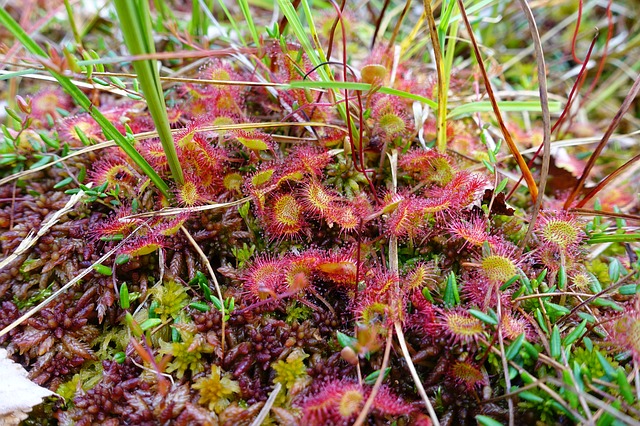 |  |  |  |  |
 |  |
Round-leaved Sundew is a perennial insectivorous plant. It has one stem, without leaves, which can reach 10-25 cm in height. In rare cases, such stems are 2-3.
The leaves of round-leaved Sundew are arranged on the soil. They have long petioles and form a root rosette. The leaves are round, up to 2 cm in diameter. The upper and lower sides of the leaves are covered with hard, red hairs on the long stems, the hairs tend to reach 4-5 mm. The hairs contain glands that secrete a sticky solution that accumulates on the surface of the plant as shiny droplets. Hairs are very sensitive to irritation. As soon as the insect touches the leaf of the round-leaved Sundew , the hairs bend to grab the victim.
The leaves of insectivores are interesting - the shape of the leaf is like a head, the upper part is covered with hairs-glands, and on each of them there is a drip that attracts a potential victim. These drops are especially brilliant in the early morning hours and in the evening sun, hence its name "Sundew".
Dew, the droplets secreted by the glands, contains a sugar solution to attract insects. The attractive droplet "dew" is a sticky slime that prevents the victim from swallowing. The leaf of the plant is sensitive to the touch, it remains for the insect to touch it and the hairs on the leaf bend to the victim, "generously" covering the victim with the sticky solution. In addition, with the help of hairs, the victim is moved to the center of the leaf - there is a digestive fringe. Gradually, the round-leaved Sundew leaf closes and becomes a conditional "stomach", where the processing of the insect takes place. Once the insect's soft tissue has been processed, only the insect's exoskeleton remains and the leaf has returned to its normal, upright position.
Round-leaved Sundew flowers are white and small, arranged in long curls. The plant blooms in June-August, the fruits ripen closer to the end of summer-beginning of autumn. The fruit is an elongated, oval capsule. The seeds are small, spindle-shaped and light brown in color.
The plants are harvested when they bloom. To harvest the plant, it is often pulled out of the soil with the entire root or judiciously cut with a sharp knife along with the soil. In cases where the plant is pulled out with the whole root, then the root should be cut off, but the grass should be rinsed from debris and moss.
It is recommended to dry the round-leaved Sundew in forced dryers at a temperature not exceeding 40C. It is also permissible to dry in a well-ventilated, shady place. However, in order to preserve as much of the substances in the plant as possible, it is necessary to dry it as quickly as possible - accordingly, it is better to use forced dryers. The drug is stored for up to 2 years.
Naphthoquinone derivatives - plumbagin and droserone (about 1%), fluoroquinolones, dyes and tannins, proteolytic enzyme, choline and acetylcholine, various acids (ascorbic acid, malic acid, citric acid, formic acid, lactic acid, benzoic acid and ellagic acid) have been found in the flowers and leaves of the round-leaved Sundew. Tannins (about 1.5%), vitamin K and mineral salts.
The mucus secreted by the hairs contains lipase, amylase, peroxidase and polysaccharides. These substances give the mucus similar properties as animal gastric juice. By eating insects, the round-leaved Sundew accumulates magnesium, potassium, phosphorus salts, as well as nitrogen and phosphorus.
Medicinal significance
Official medicine does not use or consider round-leaved Sundew as a medical remedy. On the other hand, it is known that the plant has an antispasmodic, diaphoretic and expectorant effect. The plant is a natural antiseptic that helps to deal with various skin diseases. Plumbagin, which is part of the round-leaved Sundew , effectively fights bacteria, especially those that cause whooping cough and tuberculosis. With the help of the plant, it is also possible to deal with fungal infections. round-leaved Sundew juice helps to get rid of freckles, blisters and warts.
The medicinal properties of the round-leaved Sundew are based on its chemical composition. In folk medicine, this unique plant has been known for a long time and is used to treat various health problems. Infusions and decoctions of this plant worked most effectively. This plant is used in case of long and dry cough with difficult to separate sputum. Respiratory viral infections, inflammation of the upper respiratory tract, whooping cough, tuberculosis - this is just a small list where this plant is used in folk medicine. Infusions and decoctions also help fight against headaches, asthmatic cough, fever, atherosclerosis and candidiasis.
An alcoholic extract of the plant is used to treat endarteritis, dizziness, pulmonary emphysema, tuberculosis and whooping cough. The extract also has antibacterial properties and has a destructive effect on microbial and fungal flora.
In case of skin lesions and diseases (allergies, rashes, fungal infections, dermatitis), root and decoctions of round leaves are used locally.
The juice of the round-leaved Sundew is already used to treat skin warts. The organic and enzymatic substances included in the juice have a pronounced antiviral effect. Its abilities destroy growths and promote rapid regeneration of skin cells. In addition, this remedy also helps to get rid of dry blisters and freckles.
Unacceptable forms of gastritis, enteritis, colitis and liver diseases can be treated with round-leaved Sundew . The plant effectively helps to get rid of bitter belching, flatulence, vomiting, pain in the epigastrium, heaviness in the lower abdomen.
But it is necessary to know that the round-leaved Sundew in large doses can harm and worsen the course of the disease. Therefore, before using this plant, it is important to consult a specialist to determine the correct dosage.
